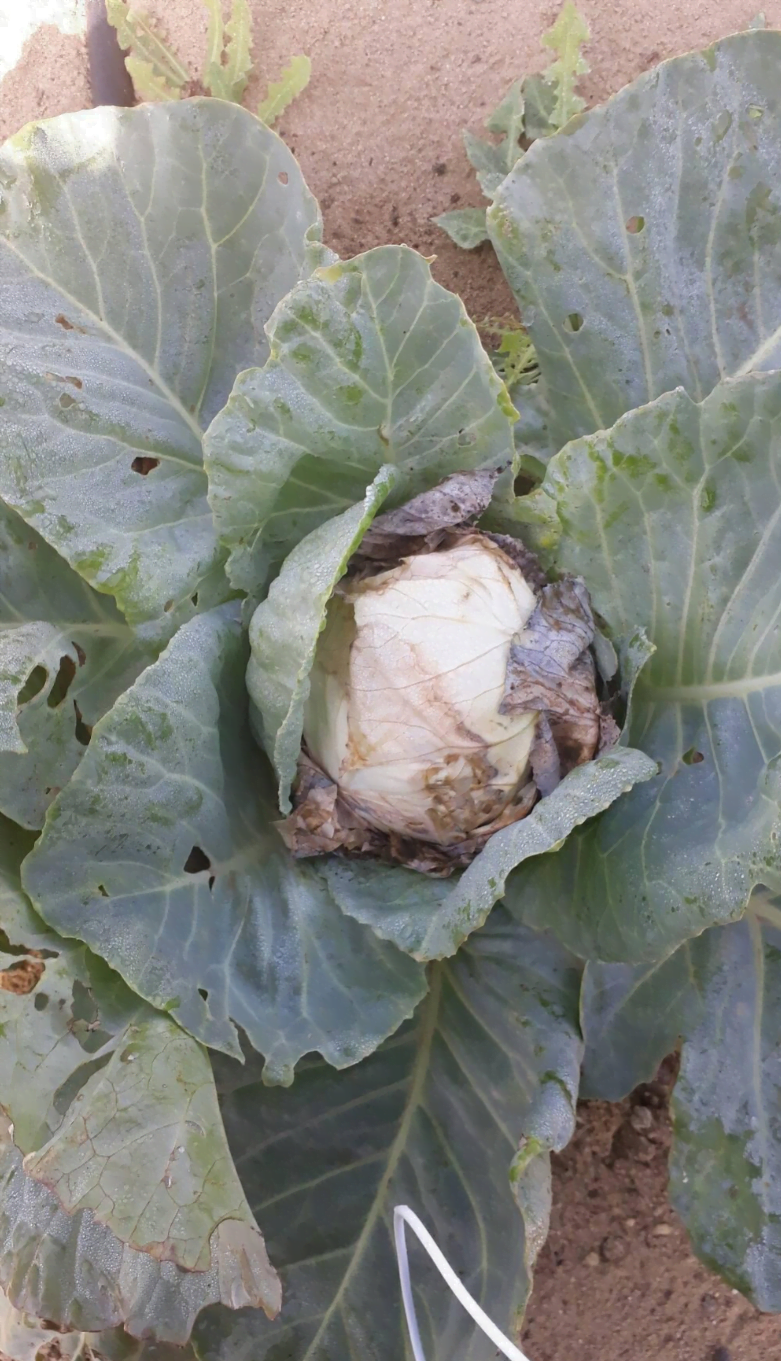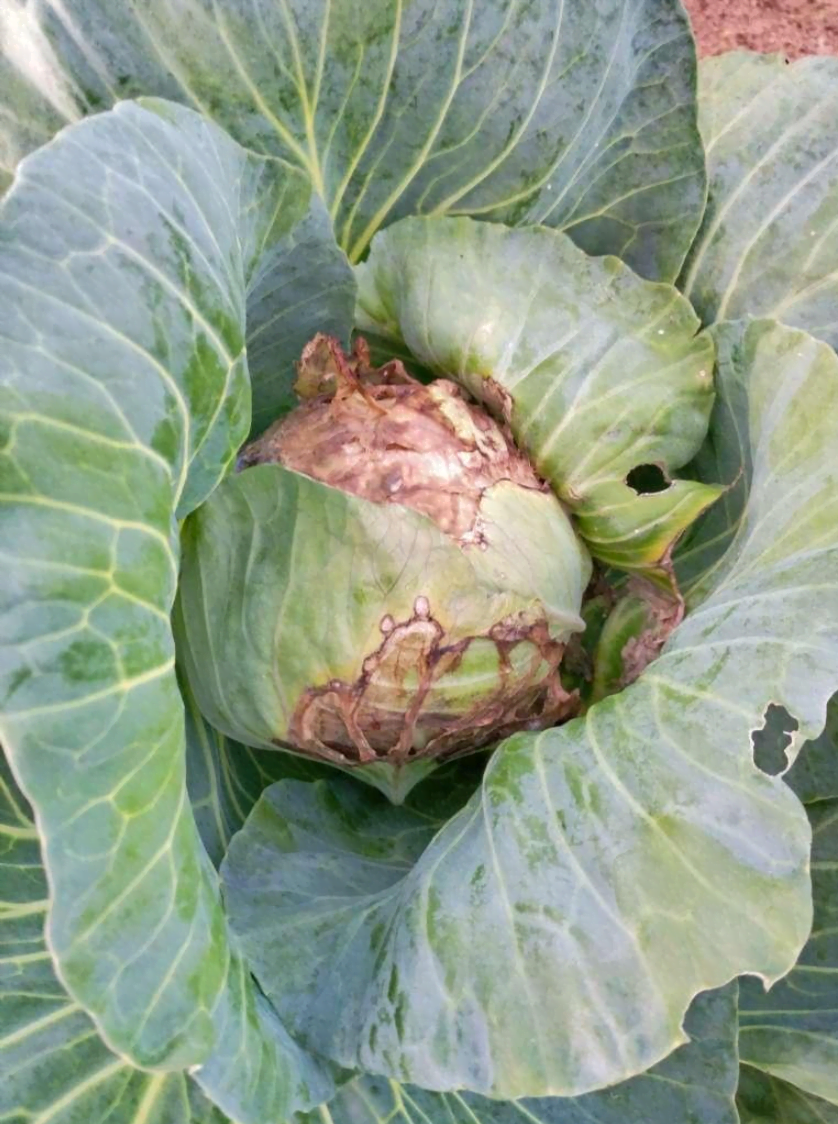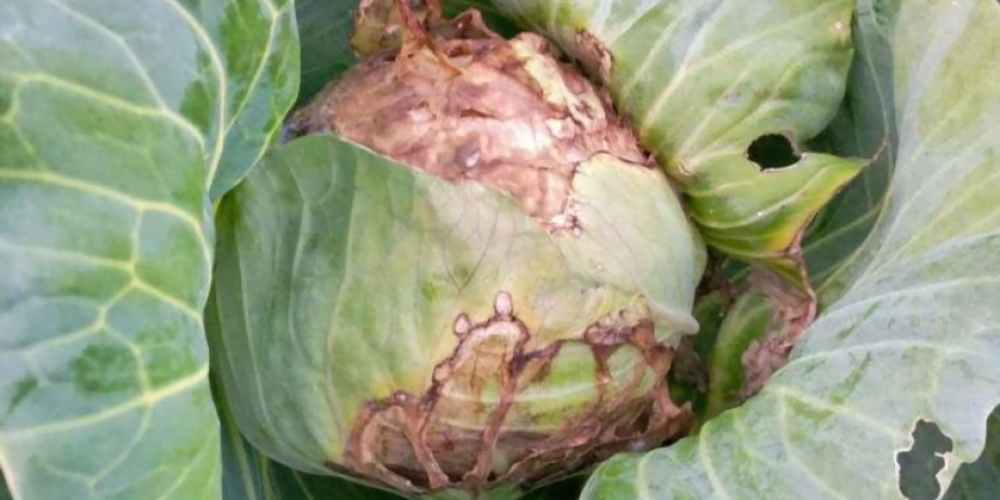Table of contents of the article
ToggleCabbage soft rot is a bacterial disease that affects cabbage plants and leads to damage to plant tissue. In this article from the “WORLD OF PLANTS” website, we review the symptoms of infection and methods of prevention and control.
Introduction to cabbage soft rot disease: Bacterial soft rot of cabbage:
Soft rot is considered one of the most dangerous bacterial diseases that affect cabbage plants in warm, humid weather. It infects plants in the field and during storage. The largest percentage of losses occurs during storage. It is more severe on plants when plants lack calcium and when nitrogen fertilization increases. This disease represents a serious threat due to the large number Among its host plants, it infects potatoes, carrots, squash, tomatoes, cucumbers, watermelon, cabbage, and cauliflower.
The pathogen of soft rot on cabbage
There are several genera of bacteria that can cause soft rot:
- Soft rots are caused by
- several bacteria, most commonly
- Pectobacterium carotovorum (previously
- called Erwinia carotovora), Dickeya
- dadantii (previously called Erwinia
- chrysanthemi), and certain species of Pseudomonas,
- Bacillus and Clostridium.
Suitable conditions for soft rot on cabbage
The infection occurs in a wide range of temperatures from 26.7 to 21°C.
Wet conditions after periods of wet weather cause free moisture on the leaves.
The minimum temperature for the spread of the disease (2-6°C) and the maximum temperature (35-41°C)
Bacteria die at temperatures higher than 50°C.
Soft rot disease cycle on cabbage
Bacteria are permanently present in the soil and in decomposing plant waste. They infect plants through natural openings: stomata on the surface of the leaves and glands located at the edges of the leaves, which are called hydathodes.
And wounds caused by agricultural tools during crop service operations, or as a result of insects, or as a result of growth cracks, or wounds resulting from cold, or burns on leaves from fertilizers.
It is also spread from one plant to another by spraying water, insects, irrigation water, and contaminated tools, especially harvesting knives.
Spread of soft rot disease on cabbage
Bacteria are present in most soils, and the pathogen is spread by irrigation water, rain, and by insects. It enters the plant through the various wounds it is exposed to and reproduces rapidly by dividing in half every 20-60 minutes in the presence of appropriate conditions (18-30 °C) in the spaces between Cells produce enzymes that break down cell walls and the middle lamina that connects the cells
Symptoms of soft rot on cabbage
Symptoms appear on the outer leaves of the head, especially those that come into contact with the soil or rub against the soil and move to the head. Symptoms appear as small spots immersed in water that expand with time and become soft and sunken and progress to affect the inner leaves of the head with a change in color to brown and then to black.
In severe cases, the leaves, stems and roots completely decompose and the tissue collapses within a few days, emitting a strong unpleasant odor.


Controlling soft rot disease on cabbage
There is no cure for soft rot, so agricultural practices, the most important of which is avoiding humid conditions, are the first key to controlling the disease, and an integrated control method must be followed according to the following:
1- Planting resistant varieties.
2- Planting disinfected seeds.
3- Agriculture in fertile soil.
4 - Plant in well-drained soil and avoid planting in water-saturated soil.
5 - Planting within the agricultural density specified for the variety to provide sufficient space for plants for ventilation.
6 - Plant with caution to prevent damage to the seedlings.
7 – Balanced nutrition and avoiding excess nitrogen fertilization.
8 - Avoid planting in shady places.
9 – Avoid overhead irrigation, regulate irrigation, and avoid frequent irrigation during head development.
10 - Controlling insects using pyrethroid compounds.
11 - Get rid of the infected plants immediately and backfill them into the soil away from the cultivated field.
12- Avoid harming plants when weeding.
13 – Preventive spraying with copper fungicides.
14 – Sterilization of agricultural equipment.
15 - Harvest during dry conditions and avoid wounding plants.
16 - Disinfect warehouses with copper sulphate to prevent head injury.
17 – Storage at a temperature below 3.9°C and a humidity of 90-95%.
18- Place layers of paper or straw between the heads of cabbage to prevent damage.
preventive measures
- Crop rotation should be followed with crops such as corn and soybeans
- Also avoid planting peppers after cabbage
- The field should be plowed deeply to reduce the number of bacteria in the soil
- Paying attention also to planting, weed control, and harvesting operations, and avoiding causing any wounds to the plants
- Sanitation guarantee
- Do not overuse nitrogen fertilizers or excessive irrigation
- Getting rid of infected plants and the remains of the previous crop
Chemical control
- You should always follow an integrated approach of preventive methods and biological control.
- Treating seeds and fruits after harvest with a diluted solution of 1% sodium hypochloride can reduce the possibility of infection with the disease.
In conclusion, we would like to note that we, at the world of plants website, offer you all the necessary services in the world of plants, we provide all farmers and those interested in plants with three main services::-
- Artificial intelligence consulting service to help you identify diseases that affect plants and how to deal with them.
- Blog about plants, plant diseases and care of various crops ... You are currently browsing one of her articles right now.
- An application that provides agricultural consultations to clients, as well as a service for imaging diseases and knowing their treatment for free – Click to download the Android version from Google Play Store، Click to download the IOS version from the Apple App Store.
References:
- Agrios, George N. (2005), “Plant Pathology,” 656–662.
- “Bacterial Soft Root.” Online International Service For Non-Chemical Pest Management in the Tropics. PAN Germany, 21 Feb 2005. Web. 26 Oct 2010. .
- Mills, AA S Plat, H. W and Hurta, RAR 2006 Sensitivity of
- Erwinia spp. to salt compounds in-vitro and their effect
- on the development of soft rot in potato tubers in storage. Post
- harvest Biology and Technology 41: 208-214.
- Milner, J. S., Dymock, D., Cooper, R. M. and Roberts, IS 1993. Penicillin.
- binding proteins from Erwinia ammglovora: mutant lacking PBP2 are
- avirulent. Journal of Bacteriology 175: 6082-6088.
- *Miura, K. 2001. Vegetable Gardening Handbook (Ed. S. Nishi and
- Yokendo), Tokyo, 163-173.
- Nasuno, S and Starr, MP1966. Polygalacturonase of Erwinia carotovora.
- Journal of Biological Chemistry 214: 5298-5306.
- Patel, PN, Trivedi, BM, Rekhi, SS, Town, PA and Rao, YP 1970.
- Black rot and stump rot in cauliflower seed crops in India. FAO
- Plant Protection Bulletin, pp. 136-141.
- Phokum.C., Jitareerat, P.,Photchanachai, S., and Cheevadhanarak, S. 2006.
- Detection and classification of soft rot Erwinia of vegetables in
- Thailand by DNA polymerase chain reaction. In: Proceedings of
- IVth International Conference on Managing Quality in Chains.
- Acta-Horticulture 712: 917-925.
- Raju, MRB, Pal, V. and Jalali, I. 2008.Inoculation method of
- Pectobacterium carotovorum sub-sp. carotovorum and factors
- influencing development of bacterial soft rot in radish. Journal of
- Mycology and Plant Pathology 38: 311-315.
- Romberg, MK, Davis, RM, Nunez, JJ and Farrar, JJ 2002. Sources and
- prevention of Erwinia early drying of potatoes in Karen county,
- California. Phytopathology 92:70.
- Russel, H.L. 1898. A bacterial rot of cabbage and allied plants. Wisconsin
- Agricultural Experimental Station Bulletin 65: 1-39.
- Schaad, N.W., Jones, J.B. and Chun. W. 2001. Laboratory Guide for
- Identification of Plant Pathogenic Bacteria. American
- Sherman, M. and Allen, J. J. 1983. Impact of post harvest handling process
- on soft rot decay of bell pepper. Proceedings of Florida State
- Horticulture Society 96: 320-322.
- Smith, C. and Bartz, JA 1990. Variation in the pathogenicity and
- aggressiveness of strains of Erwinia carotovora sub sp. carotovora
- isolated from different hosts. Plant Disease 74: 505-509.
- Tanaka, T. and Kikumoto, T. 1976. Inhibition of growth and movement of
- soft rot bacteria by lowering the water content in the leaf tissue of
- Chinese cabbage. Bulletin of the Institute for Agricultural Research,
- Thind, B.S. 1987. Laboratory Manual of Plant Bacteriology. Department
- of Plant Pathology, PAU, Ludhiana, p. 62.
- Thornberry, H.H. 1950. A paper disc plate method for quantitative research
- Togoshi, J., Takahashi, S. and Shibata. 1988. Bacterial soft rot in red turnip
- Brassica compertris L. (rapifera group) cv. Atsumi-kabu, grown in
- Tsuyama, H. 1961. Studies on the soft rot disease of Chinese cabbage
- Caused by Erwinia aroideae. Bulletin of Institute of Agricultural
- Research, Tohoku University 13: 221-345.
- Umekawa, M. 1991. Bacterial soft rot of cabbage. In: Bacterial crop
- disease in Japan – A guide for diagnoses and control [Ed. H. Tabei].
- Japan Plant Protection Association, pp. 215-216.
- Walker, J.C. 1998a. Bacterial soft rots of carrot. In: Diseases of vegetables
- Crops. Discovery Publishing House Ansari road, New Delhi, p. 78.
- Walker, J.C. 1998b. Bacterial soft rots of carrot. In: Diseases of vegetables
- Crops. Discovery Publishing Company, New Delhi, pp. 184-215.
- Wood, R. K. S. 1960. Pectic and cellulolytic enzymes in plant disease.
- Annual Review of Physiology 11: 299-322.




